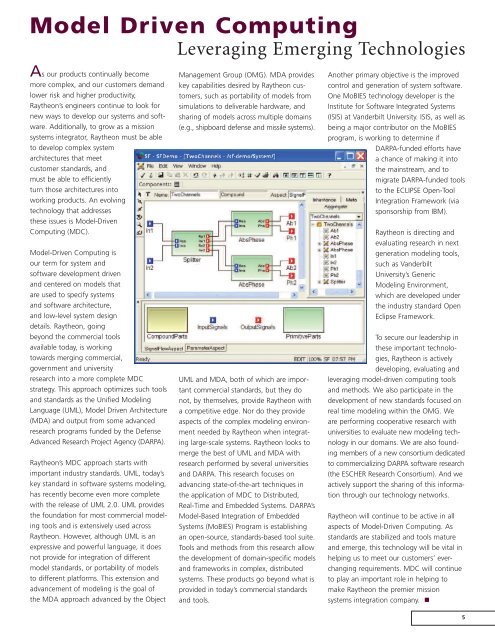TT_Vol3 Issue2 - Raytheon
TT_Vol3 Issue2 - Raytheon
TT_Vol3 Issue2 - Raytheon
You also want an ePaper? Increase the reach of your titles
YUMPU automatically turns print PDFs into web optimized ePapers that Google loves.
Model Driven Computing<br />
Leveraging Emerging Technologies<br />
As our products continually become<br />
more complex, and our customers demand<br />
lower risk and higher productivity,<br />
<strong>Raytheon</strong>’s engineers continue to look for<br />
new ways to develop our systems and software.<br />
Additionally, to grow as a mission<br />
systems integrator, <strong>Raytheon</strong> must be able<br />
to develop complex system<br />
architectures that meet<br />
customer standards, and<br />
must be able to efficiently<br />
turn those architectures into<br />
working products. An evolving<br />
technology that addresses<br />
these issues is Model-Driven<br />
Computing (MDC).<br />
Model-Driven Computing is<br />
our term for system and<br />
software development driven<br />
and centered on models that<br />
are used to specify systems<br />
and software architecture,<br />
and low-level system design<br />
details. <strong>Raytheon</strong>, going<br />
beyond the commercial tools<br />
available today, is working<br />
towards merging commercial,<br />
government and university<br />
research into a more complete MDC<br />
strategy. This approach optimizes such tools<br />
and standards as the Unified Modeling<br />
Language (UML), Model Driven Architecture<br />
(MDA) and output from some advanced<br />
research programs funded by the Defense<br />
Advanced Research Project Agency (DARPA).<br />
<strong>Raytheon</strong>’s MDC approach starts with<br />
important industry standards. UML, today’s<br />
key standard in software systems modeling,<br />
has recently become even more complete<br />
with the release of UML 2.0. UML provides<br />
the foundation for most commercial modeling<br />
tools and is extensively used across<br />
<strong>Raytheon</strong>. However, although UML is an<br />
expressive and powerful language, it does<br />
not provide for integration of different<br />
model standards, or portability of models<br />
to different platforms. This extension and<br />
advancement of modeling is the goal of<br />
the MDA approach advanced by the Object<br />
Management Group (OMG). MDA provides<br />
key capabilities desired by <strong>Raytheon</strong> customers,<br />
such as portability of models from<br />
simulations to deliverable hardware, and<br />
sharing of models across multiple domains<br />
(e.g., shipboard defense and missile systems).<br />
UML and MDA, both of which are important<br />
commercial standards, but they do<br />
not, by themselves, provide <strong>Raytheon</strong> with<br />
a competitive edge. Nor do they provide<br />
aspects of the complex modeling environment<br />
needed by <strong>Raytheon</strong> when integrating<br />
large-scale systems. <strong>Raytheon</strong> looks to<br />
merge the best of UML and MDA with<br />
research performed by several universities<br />
and DARPA. This research focuses on<br />
advancing state-of-the-art techniques in<br />
the application of MDC to Distributed,<br />
Real-Time and Embedded Systems. DARPA’s<br />
Model-Based Integration of Embedded<br />
Systems (MoBIES) Program is establishing<br />
an open-source, standards-based tool suite.<br />
Tools and methods from this research allow<br />
the development of domain-specific models<br />
and frameworks in complex, distributed<br />
systems. These products go beyond what is<br />
provided in today’s commercial standards<br />
and tools.<br />
Another primary objective is the improved<br />
control and generation of system software.<br />
One MoBIES technology developer is the<br />
Institute for Software Integrated Systems<br />
(ISIS) at Vanderbilt University. ISIS, as well as<br />
being a major contributor on the MoBIES<br />
program, is working to determine if<br />
DARPA-funded efforts have<br />
a chance of making it into<br />
the mainstream, and to<br />
migrate DARPA-funded tools<br />
to the ECLIPSE Open-Tool<br />
Integration Framework (via<br />
sponsorship from IBM).<br />
<strong>Raytheon</strong> is directing and<br />
evaluating research in next<br />
generation modeling tools,<br />
such as Vanderbilt<br />
University’s Generic<br />
Modeling Environment,<br />
which are developed under<br />
the industry standard Open<br />
Eclipse Framework.<br />
To secure our leadership in<br />
these important technologies,<br />
<strong>Raytheon</strong> is actively<br />
developing, evaluating and<br />
leveraging model-driven computing tools<br />
and methods. We also participate in the<br />
development of new standards focused on<br />
real time modeling within the OMG. We<br />
are performing cooperative research with<br />
universities to evaluate new modeling technology<br />
in our domains. We are also founding<br />
members of a new consortium dedicated<br />
to commercializing DARPA software research<br />
(the ESCHER Research Consortium). And we<br />
actively support the sharing of this information<br />
through our technology networks.<br />
<strong>Raytheon</strong> will continue to be active in all<br />
aspects of Model-Driven Computing. As<br />
standards are stabilized and tools mature<br />
and emerge, this technology will be vital in<br />
helping us to meet our customers’ everchanging<br />
requirements. MDC will continue<br />
to play an important role in helping to<br />
make <strong>Raytheon</strong> the premier mission<br />
systems integration company. �<br />
5
















